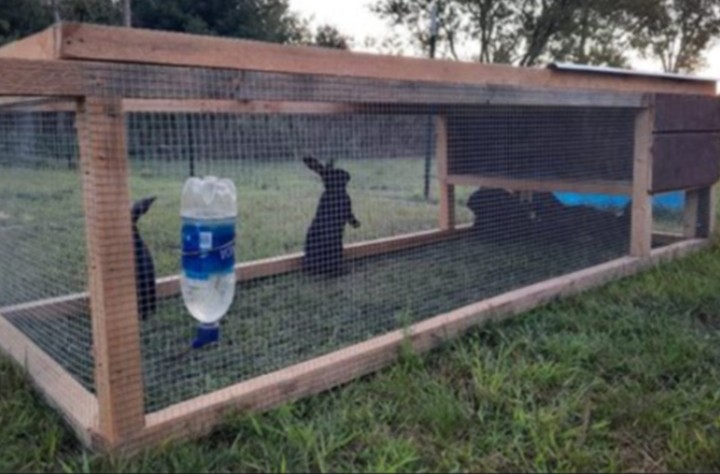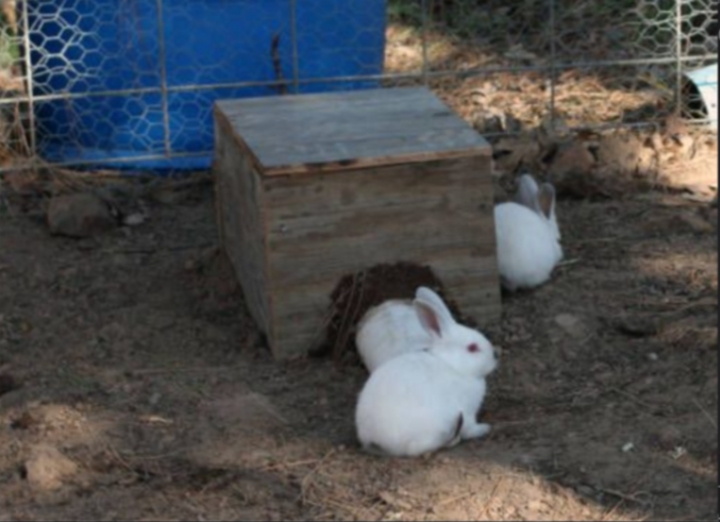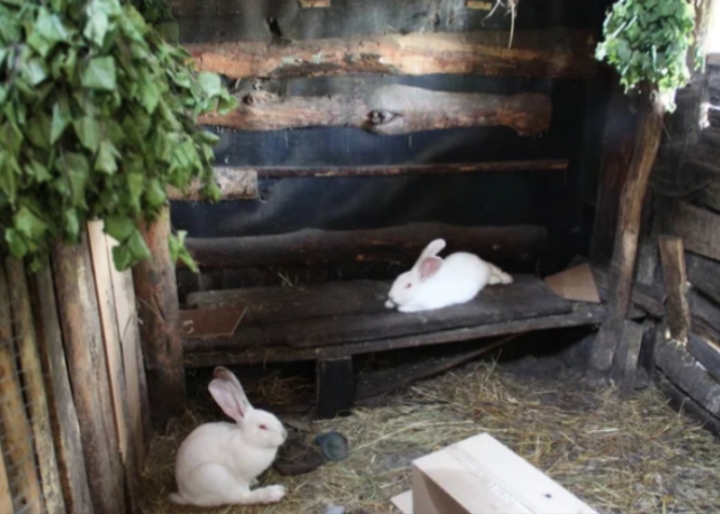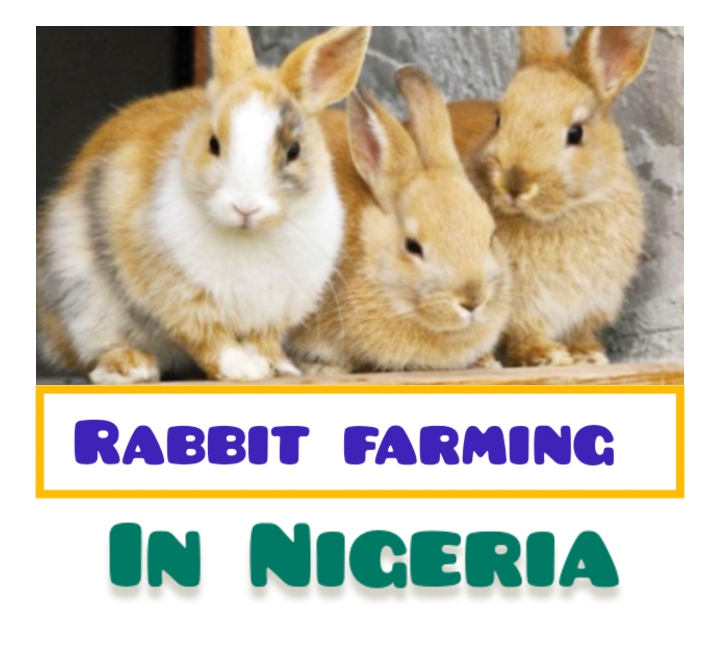Types of Housing for Meat Rabbits
Proper housing plays a crucial role in the successful production of meat rabbits. The environment in which rabbits are raised affects their health, growth, and overall well-being. Choosing the right type of housing is important to ensure the comfort and productivity of the rabbits.
When selecting housing for meat rabbits, several factors have to be considered. Some of which include: Climate conditions, Space, Budget, e.t.c. More on this later. But first, let us take a look at the types of housing for your rabbits.
1) Hanging Cages/Wire Cages
Hanging cages, also known as wire cages, are a popular housing option for meat rabbits. These cages are typically suspended above the ground, allowing for easy cleaning and waste removal.

They are constructed with wire mesh, providing adequate ventilation and airflow for the rabbits.
Advantages
The benefits of hanging cages for meat rabbits include:
1. Easy cleaning and waste removal: The design of hanging cages allows droppings to fall through the wire mesh, making cleaning a simple and efficient task.
2. Better air circulation: The open mesh design of wire cages promotes airflow, helping to prevent respiratory issues and maintain a healthy environment for the rabbits.
3. Efficient use of space: Hanging cages maximize vertical space, allowing for the housing of multiple rabbits in a compact area.
Disadvantages
Despite their advantages, hanging cages also have some disadvantages:
1. Potential foot injury/sore hocks: The wire mesh flooring of hanging cages can cause discomfort and injury to the rabbits’ feet, leading to sore hocks if not properly managed.
2. Lack of space for movement: Rabbits housed in hanging cages may have limited space to move around, which can impact their physical and mental well-being.
3. Higher initial cost: The construction of hanging cages can be more expensive than other housing options, requiring upfront investment in materials and installation.
2) Hutches/Tractor Systems
Hutches and tractor systems are alternative housing options for meat rabbits.
Hutches are small, individual shelters typically made of wood or metal and placed on the ground.

Tractor systems are movable enclosures that allow rabbits access to fresh grass and outdoor areas while still providing protection.

Advantages
The benefits of hutches and tractor systems for meat rabbits include:
1. Ample space for movement and exercise: Hutches and tractor systems provide rabbits with more space to move around compared to hanging cages, allowing for increased exercise and natural behavior.
2. Access to outdoor areas: Tractor systems allow rabbits to graze on fresh grass and experience outdoor environments, which can contribute to their overall health and well-being.
3. Lower initial cost: Hutches and homemade tractor systems can be more cost-effective to construct compared to hanging cages, making them a budget-friendly option for rabbit farmers.
Disadvantages
However, hutches and tractor systems also come with some disadvantages:
1. More difficult cleaning and waste management: Hutches and tractor systems require regular cleaning and maintenance to prevent the buildup of waste and bedding material, which can be more labor-intensive compared to hanging cages.
2. Potential predator issues: Rabbits housed in outdoor hutches or tractor systems may be more vulnerable to predation from local wildlife, such as foxes, raccoons, or birds of prey.
3. Limited mobility (for stationary hutches): Rabbits housed in stationary hutches may have limited mobility and access to fresh grazing areas, which can affect their overall health and well-being over time.
3) Colony/Floor Pens
Colony pens, also known as floor pens, provide a communal living environment for meat rabbits.

These pens typically consist of an enclosed area with a solid floor, allowing rabbits to move freely and interact with one another.
Colony pens aim to mimic rabbits’ natural living conditions by allowing them to socialize and exhibit natural behaviors.
Advantages
The benefits of colony pens for meat rabbits include:
1. Simulates natural living environment: Colony pens offer rabbits the opportunity to live in groups, mimicking their natural social structure and behavior patterns.
2. Allows for group housing: Rabbits housed in colony pens can benefit from social interaction, which can reduce stress and improve overall well-being.
3. Lower initial cost: Colony pens can be more cost-effective to set up compared to individual cages or hutches, making them a budget-friendly option for rabbit farmers.
Disadvantages
Colony pens also come with some disadvantages:
1. Requires more space: Colony pens require a larger footprint compared to individual cages or hutches, as they must accommodate multiple rabbits.
2. Increased risk of disease transmission: With multiple rabbits housed in close proximity, there is an increased risk of disease transmission, requiring careful management and hygiene practices.
3. Difficult waste management: Waste management can be more challenging in colony pens, as the accumulation of droppings and bedding material can lead to sanitation issues if not properly managed.
Other Housing Options
4) Barn/Shed Systems
Barn or shed systems are larger-scale housing options for meat rabbits.

These systems typically consist of enclosed structures with multiple compartments or pens for housing rabbits.
They provide protection from the elements and can accommodate a larger number of rabbits compared to individual cages or hutches.
Advantages and disadvantages of barn/shed systems include:
Advantages:
- Ample space: Barn/shed systems offer plenty of room for rabbits to move around and exercise.
- Protection: The enclosed structure provides protection from extreme weather conditions and predators.
- Versatility: Barns or sheds can be adapted to accommodate various management practices, such as breeding, growing, and processing rabbits.
Disadvantages:
- Higher initial cost: Constructing or purchasing a barn or shed can be expensive compared to other housing options.
- Maintenance: Barns or sheds require regular maintenance to ensure structural integrity and hygiene.
- Space requirements: Barn/shed systems require sufficient land area for construction and may not be suitable for all farming operations.
5) Mobile/Pasture Pens
Mobile or pasture pens are movable “Hutch or Tractor” type housing structures designed to allow rabbits access to fresh pasture. These pens are typically lightweight and portable, allowing them to be moved to different areas of pasture or grazing land. They provide rabbits with access to fresh forage and outdoor environments while still providing protection from predators.
Advantages and disadvantages of mobile/pasture pens include:
Advantages:
- Grazing opportunity: Mobile pens allow rabbits to graze on fresh pasture, which can improve their diet and overall health.
- Natural behavior: Rabbits housed in mobile pens can exhibit natural behaviors, such as foraging and digging, which promotes mental stimulation and well-being.
- Flexibility: Mobile pens can be easily moved to different areas of pasture, allowing for rotational grazing and land management practices.
Disadvantages:
- Predation risk: Rabbits housed in mobile pens may be more vulnerable to predation from wildlife, requiring additional measures to protect them.
- Limited protection: Mobile pens may not provide as much protection from adverse weather conditions compared to more permanent housing structures.
- Mobility constraints: Moving mobile pens regularly can be labor-intensive and may not be practical for all farming operations.
Factors to Consider
Climate and Weather Conditions
You have to consider the local climate and weather patterns when choosing housing for meat rabbits. Ensure that the housing provides adequate protection from extreme temperatures, rain, wind, and other environmental factors.
Available Space and Resources
You must first and foremost evaluate the amount of space available for housing rabbits on your farm or property. Consider the resources you have access to, such as land, materials, and labor, when selecting the appropriate housing option.
Budget and Initial Investment
Determine your budget for constructing or purchasing rabbit housing. Consider the initial investment required for different housing options, including materials, labor, and ongoing maintenance costs.
Ease of Management and Cleaning
Assess the ease of management and cleaning for each housing option.
Choose housing that allows for efficient waste removal, ventilation, and maintenance to ensure a clean and sanitary environment for the rabbits.
Animal Welfare and Behavioral Needs
Lastly, you need to prioritize the welfare and behavioral needs of the rabbits when selecting housing.
Choose housing options that provide ample space for movement, social interaction, and natural behaviors, such as burrowing and grazing.
By considering these factors carefully, you can choose the most suitable housing option for your meat rabbit operation, ensuring the health, well-being, and productivity of your rabbits.
Frequently asked questions
What type of housing is best for a rabbit?
The best housing for a rabbit depends on factors like climate, space available, and budget. Wire cages allow easy cleaning but don’t give rabbits much room. Hutches or pens give rabbits more space to move around and access to the outdoors.
What is the best cage for a meat rabbit?
For meat rabbits, Wire cages are often used as they are easy to clean and provide good ventilation. However, rabbits need space to move so cages should be as large as possible.
What are meat rabbits called?
Rabbits raised specifically for their meat are called meat rabbits or fryer rabbits. Popular meat breeds include New Zealand, Californian, Flemish Giant, and Palomino.
At what age do you slaughter rabbits?
Most meat rabbits are slaughtered between 8-12 weeks old when they reach around 4-5 pounds. This is considered the ideal fryer weight and size.
How many babies do meat rabbits have?
Meat rabbit breeds like New Zealands typically give birth to litters of 6-12 kits (babies) at a time after a 31 day pregnancy.
What is the largest breed of rabbit for meat?
The Flemish Giant is the largest breed of rabbit and can weigh up to 20 pounds. They produce a good amount of meat but breeding tends to be more difficult.
How long are meat rabbits pregnant?
The typical rabbit gestation period is about 31 days before giving birth to a litter of kits. Rabbits are able to breed very quickly. Females can get pregnant again shortly after kindling (giving birth) and have several litters per year.
What is the best food for meat rabbits?
A diet of unlimited grass hay (timothy, oat, etc) plus a pelleted ration formulated for rabbits provides ideal nutrition for growing meat rabbits.
Can rabbits and chickens live together?
Rabbits and chickens generally should not live together. Chickens may bully or injure rabbits by pecking them, and rabbits can catch diseases from chickens.
Is rabbit meat expensive?
Compared to other meats like chicken or beef, rabbit meat is considered more expensive per kg in most stores and markets.
Can rabbits pass diseases to chickens?
Yes, there is potential for rabbits to pass certain diseases to chickens and vice versa through exposure to one another’s droppings or saliva.
How do I keep my rabbits healthy?
Provide a proper diet, clean housing, exercise space, safety from predators, and routinely groom and check for illness. Annual vet checkups also promote good health.
Do rabbits need light at night?
No, rabbits do not require light at night and can see very well in the dark. Too much lighting at night can disturb their natural sleep cycles.
What do rabbits do at night?
Rabbits are crepuscular, meaning most active at dawn and dusk. At night they spend time resting, grooming, foraging and being alert for predators.
What is a male and female rabbit called?
A male rabbit is called a buck. A female rabbit is called a doe. Baby rabbits are called kits or kittens.
Conclusion
We have explored various housing options for meat rabbits, including hanging cages/wire cages, hutches/tractor systems, colony/floor pens, barn/shed systems, and mobile/pasture pens.
Each housing option has its own unique features, advantages, and disadvantages, allowing rabbit farmers to choose the option that best suits their specific needs and preferences.
However, regardless of the housing option chosen, proper management and hygiene practices are essential for maintaining a clean and healthy environment for your rabbits.
Regular cleaning, waste removal, ventilation, and monitoring are key aspects of successful rabbit housing management. By prioritizing proper management and hygiene, you can ensure the longevity and success of your meat rabbit operation.
In conclusion, choosing the right housing for your meat rabbits is a critical decision that requires careful consideration of various factors. By selecting housing options that meet the needs of your rabbits and implementing proper management practices, you can create a safe, comfortable, and productive environment for your rabbits to thrive.





